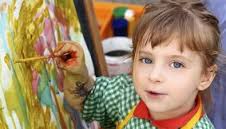Arts Education to Encourage Creativity and Build Self-Esteem
Author: J. T. Cane
If an individual develops low self-esteem at a young age they may find it harder and harder to keep up with life’s demands later on; in families, at school, socially, and in a career. Low self-esteem involves a fear of exercising one’s potential (May, R., Angel, E., & Ellenberger, H. F., p. 31, 1994). When we are creative we exercise our potential unconditionally to grow and enrich our experience of life by adding to it. There are certain pedagogical practices that encourage creativity, which, in turn, can assist in the effective development of lifelong learning practices (Ya-Hui, 2009).
Activities, especially arts-related activities, for children early on are important; they have been proven to boost a child’s self-image; whether in an individual setting or as part of a group, arts and creativity in education improves a child’s confidence (Annis, 2013). For example, studies have shown that when children participate in art and creative activities with peers, the feedback they give to each other builds self-respect by helping them learn to accept criticism and praise from others (Berger, 2003). The arts can instill pride. When a child puts their heart and soul into an art project, cultivating it, and making it pleasing, they can feel an immense sense of achievement when it is complete (Bowman, 2007). The arts (Kanter) level the playing field because all are learning to create and succeed in new ways. Children can appreciate the work of others and develop skills of self-reflection in the effort to bring their personal vision to completion (2003). Students (Kanter) can make a personal connection to a subject through the arts, consequently they deepen their thinking through a creative action. Through creative problem solving students can learn persistence and improved thinking skills (2003). When a child invests time in creating a completed work of art, they increase their ability to commit to responsibilities which can extend into the future (Ruppert, 2006).
Self-esteem increases when a child feels confident in the classroom (Canfield & Wells, 1976). Skills learned when engaging in artistic activities including focus and perseverance, affects classroom values and test scores. A 2005 Harris Poll (Ruppert, 2006) found that 93 percent of Americans agreed the arts are vital to providing a well-rounded education for children. In another (Catterall) study, 12 years of data was collected for the National Educational Longitudinal Survey to look at the effect of education, visual, and performing arts on the achievement and values of children. The study discovered that students who were immersed in the arts outperformed less-involved peers, even within low socioeconomic groups. Specifically, music can enhance classroom skills, involving critical thinking, creative problem solving, working together, and effective communication (2012).
The arts can encourage chances for self-expression. A (Ruppert) creative environment offers a child an unconditional setting to express themselves. When students are working together, they are grateful when their “voice” and interests are heard and accepted by others. This shared effort creates a sense of security that is vital to their self-esteem (2006).
Community art programs (Lowe) can help familiarize a child to new people, situations and experiences; increasing a sense of belonging to a community to enhance self-esteem. These settings can encourage a child to engage in social and creative activities; learning about trust and developing social skills and friendships (2000).
Creative environments invite children to experiment with supplies, techniques, and directions that are often foreign and intimidating (Katz & Chard, 2000). Tackling and becoming adept at creative new tasks brings satisfaction to children of all ages. These (Mayesky) settings encourage children to push themselves to plan and finish an entire project. Children feel a great sense of accomplishment when they are responsible for completing an entire task from beginning to end (2011).
Classes of creative art produce a fruitful environment for meeting and interacting with other children and adults, to go beyond their comfort zones. It is a boost to self-esteem (Baumeister, 2010) for children to play and work with new friends. Arts and crafts classes influence children to take risks (Ruppert) by taking on challenges associated with creating something from nothing; also when one puts their work out there for others to see, it exercises an innate sense of self-trust which strengthens self-esteem (2006). A supportive environment can help children feel comfortable exposing their work (Katz & Chard, 2000). Creative questions do not have predetermined answers like a math problem. When doing arts and crafts (Wright & Etchells, 2001) children learn how to be open-minded exploring different possible solutions through the tasks they face.
Children who develop their self-esteem (Baumeister, 2010) through creativity are curious about learning new things. Being imaginative and open minded allows for them to invent solutions that are exciting and inspired through creative activity (Wright & Etchells, 2001). Children gain the confidence to tackle many problems in creative and inventive ways. When exercising creativity a child can dismiss any preconceived ideas they may have had about themselves regarding limiting ideas (Baumeister) about their own abilities that restrict their view of life; helping to change damaging preconceived beliefs (2010). Children learn how truly capable they are and can build on each experience creating confidence with each project, achieving success which inspires children to reach for more and attempting more difficult challenges (Ruppert, 2006). Creative environments can nurture a play mentality which allows children to have fun, exploring their imaginative side more effectively.
About the Author
For over 15 years, John Cane has helped over 100,000 individuals in areas of Self Improvement. John is a Life Coach, motivational speaker and writer who develops and implements confidence and self-esteem workshops in Baltimore, Florida, Georgia, Illinois, New York, North Carolina, South Carolina, and Virginia. With a background in Psychology, he has six certifications in Personal Growth and Development. His Journal Books, ‘Important Things I Remember from My Parents’ are used in schools and as an aid for adults in gaining strength in self identity in the United States and Europe.
John Cane is the founder of Edge Advantage, Inc. Edge Advantage (www.seetheobvious.com) is a personal development organization dedicated to research-based, practical psychology training. Our focus is on communication, individual performance, and reducing stress. The objective of John’s websites is to bring the most current developments from these areas to those who use them everyday, educating in a form that is clear and practical. John is the webmaster of Self Help Guides Online (.com) and See the Obvious (.com). He is currently pursuing his Graduate Degree in Psychology & Interdisciplinary Inquiry at Saybrook University, Oakland, California. His specialization, Psychology of Creativity Studies focuses on a growth-oriented perspective emphasizing human potential, intended to broaden an in-depth understanding of the everyday creativity every individual possesses.
(Leave us a suggestion for articles you would like to see. We will do our best to suit your needs!)
Did this information help? I hope so. Change can be difficult sometimes. Like I always say in my workshops, It’s not always easy, but it’s worth it because you’re worth it!
Donations fund Self Esteem Workshops for teens, supply books to schools for the continual support of character education across America, and are tax deductable.
Thank you from Self Help Guides!





